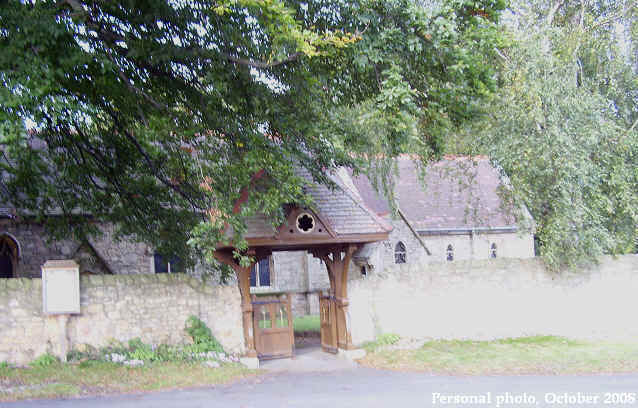The Chapel at Skelbrooke
The chapel at Skelbrooke has an uncertain history. According to the Yorkshire Archaeological Journal it was built sometime between 1180 and 1220, dedicated to St Michael, and in the patronage of St Mary Magdalen of Monk Bretton, suggesting this was the chapel of Mary Magdalen made by Robin which is mentioned in the closing versus of the Gest. The journal also tells us that the Prior of Monk Bretton presented to the Chantry which Agnes Butlere wife of Edmund Butlere of Skelbroke, founded on the north side of the Chappell of St. John of Skelbroke, (this is dated to 1383) and also that the Chantry was destroyed at the reformation and the site occupied by a mortuary chapel.(see Y.A. J.) Joseph Hunter believed that the chapel was founded by the Butlers, the early lords of Skelbrook, and that a Chantry was ordained in the chapel in 1338 by Agnes le Boteler; this is mentioned along with other details in his South Yorkshire. Some of Hunter’s details are repeated by J.W. Walker in the Yorkshire Archaeological Journal of 1944, but here the chapel is called the Chapel of All Saints.(see Y.A.J) Eric Houlder (British Archaeology issue no. 48, 1999) records that Skelbrooke Church was demolished and rebuilt in the nineteenth century, but still retains fragments of the 12th century work. The church was damaged by fire in 1870, rebuilt in 1872, and the chapel restored by the Neville family who owned the estate at that time; this and other information is supplied by Canon Stanley K Reynolds. The church is now called St. Michael and All Angels Parish Church, and nearby is Skelbrooke Hall, thought to be on the site of the former home of the Butlers.
The name of Butler is common in England, but also in Ireland, where it appears to date from about the year 1220, due to the fact that Theobald Fitzwalter was created Chief Butler of Ireland in 1177. (1) According to Joseph Hunter, the le Boteler or le Butler family of Skelbrook, were the descendants of a person by the name of Harvey who lived in the reign of the conqueror, a tenant under the Lacis in Domesday Book, but he thought that ‘The Butlers of Skelbrook were a different race from the Butlers of Ireland’ (South Yorkshire, vol. 2, p. 457). The precise history of the Skelbrooke Butlers is uncertain, but the earliest mention of the family may be dated to about 1160, when Robert Butler, possibly the great uncle of one Hugh Pincerna, witnessed a grant by Adam Fitz Peter to Pontefract Priory of land in Fareburn. A later Robert Butler, a descendant, was captured and taken to York on suspicion of homicide and other transgressions in 1293. He admitted that he was a thief (se esse latronem), turned approver, and appealed many (named) persons of being thieves and receivers. Those named were: Alice Hotty of Skelagh and her sister Matilda, Colle of Burgh Walleys the man of Richard Tyes, Thomas son of Sybil of Skelagh, William the man of William del Sayles living in Skelbrook, John son of Sen’ of Doncaster, Thomas chaplain of Skelagh formerly living at Doncaster, William Luggeto sergeant of Arnethorp, Adam le Waleys of Skelagh, Geoffrey le Mouner of Skelbrook, Adam Alman, Benedict son of Thomas of Slepyl living at Kekelton, William son of Stephen of burgh Waleys, Robin son of Walter Walschef of Elmsale, William Smith of Leicester and his wife, John Skyllare of Lancaster, William Curry of Tickhill, John the Goldsmith of Doncaster, Robert le Mouner of Paynel Hoton and William Maureward. Robert Butler admitted his theft, homicide, and rape to the coroner, who wrote his confession and handed it to the justices, who sent for the said Robert to see if he would like to be made in court what he admitted to the coroner, but Robert claimed he was of the clergy, had done no wrong, and had been forced to confess. He was apparently pressed to death in 1294. The barbarous custom of pressing to death, known as la peine forte et dure, was used where a person accused of felony refused to plead and stood, as the phrase went, ‘mute of malice.’ He was stripped, laid on his back on the bare ground, and as much iron and weights as he could bear, et plus, were placed on him, so that he could not rise; he was given to eat of the worst bread that could be found, and to drink of the water nearest to the gaol, except running water; he had nothing to drink on the day that he ate, and nothing to eat on the day that he drank. This was kept up until he either pleaded or died. The object of the prisoner was to avoid forfeiture, which followed on a conviction for felony; by refusing to plead, he could not be tried, and consequently could not be convicted.(2)
1. This information was found in Irish Families Their Names, Arms and Origins, Edward MacLysaght, (formerly Chief Herald of Ireland) Dublin, 1972., pp. 67-68.
2. This information was found in Notes on the Early Saville Pedigree and the Butlers of Skelbrook and Kirk Sandal, YAJ, vol. 29, pp 69, 80, 81, (1929), by the Late W. Paley Baildon, F.S.A. (Electronic text and additional notes provided by David Hepworth)
St Michael and All Angels Parish Church, Skelbrook
 The entrance to the churchyard, with the coat of arms above the doorway of the church, just visible to the right of the notice board.
The entrance to the churchyard, with the coat of arms above the doorway of the church, just visible to the right of the notice board.
Back to Barnsdale and Sherwood

|